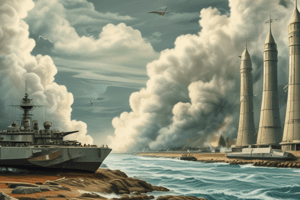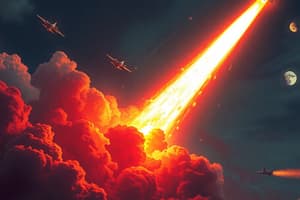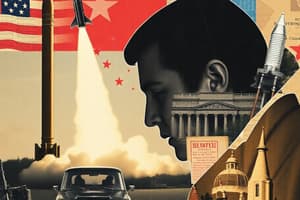Podcast
Questions and Answers
What significant agreement did Khrushchev and Kennedy come to after the Cuban missile crisis?
What significant agreement did Khrushchev and Kennedy come to after the Cuban missile crisis?
- The US would invade Cuba.
- Both nations would increase their nuclear arsenals.
- The US would increase military presence in Turkey.
- Khrushchev would withdraw missiles from Cuba. (correct)
Which major communication system was established as a result of the Cuban missile crisis?
Which major communication system was established as a result of the Cuban missile crisis?
- A Moscow-Washington 'hot line.' (correct)
- An international crisis negotiation treaty.
- A NATO command center in Europe.
- A direct satellite link between NATO and the Soviet Union.
What was the main focus of Kennedy's speech at American University in June 1963?
What was the main focus of Kennedy's speech at American University in June 1963?
- To urge nuclear disarmament from all nations.
- To call for an immediate end to the Cold War.
- To promote a military build-up against the Soviet Union.
- To advocate for a view of peaceful coexistence with the Soviet Union. (correct)
What term describes the policy that emerged from efforts for relaxation of tensions between the US and the Soviet Union?
What term describes the policy that emerged from efforts for relaxation of tensions between the US and the Soviet Union?
What was one of the outcomes of the Cuban missile crisis for Kennedy?
What was one of the outcomes of the Cuban missile crisis for Kennedy?
What happened to Khrushchev after the Cuban missile crisis?
What happened to Khrushchev after the Cuban missile crisis?
What significant action did the U.S. take concerning its own missiles following the Cuban missile crisis?
What significant action did the U.S. take concerning its own missiles following the Cuban missile crisis?
What caused hard-liners in Moscow to react aggressively after the crisis?
What caused hard-liners in Moscow to react aggressively after the crisis?
What was the primary goal of Kennedy's Alliance for Progress?
What was the primary goal of Kennedy's Alliance for Progress?
What was a significant outcome of the Bay of Pigs invasion?
What was a significant outcome of the Bay of Pigs invasion?
What strategic decision did Kennedy make regarding the Cuban missile crisis?
What strategic decision did Kennedy make regarding the Cuban missile crisis?
During the Cuban missile crisis, what did Kennedy threaten in response to an attack from Cuba?
During the Cuban missile crisis, what did Kennedy threaten in response to an attack from Cuba?
What method did the U.S. use to attempt to overthrow Fidel Castro's regime before the Bay of Pigs invasion?
What method did the U.S. use to attempt to overthrow Fidel Castro's regime before the Bay of Pigs invasion?
What was one of the consequences of the Bay of Pigs invasion for the United States?
What was one of the consequences of the Bay of Pigs invasion for the United States?
What type of support did the U.S. provide to Cuban exiles during the Bay of Pigs invasion?
What type of support did the U.S. provide to Cuban exiles during the Bay of Pigs invasion?
What event heightened tensions between the U.S. and the Soviet Union prior to the Cuban missile crisis?
What event heightened tensions between the U.S. and the Soviet Union prior to the Cuban missile crisis?
Flashcards
Cuban Missile Crisis
Cuban Missile Crisis
A tense standoff between the United States and the Soviet Union in 1962, sparked by the Soviet Union attempting to install nuclear missiles in Cuba.
Cuban Missile Crisis Resolution
Cuban Missile Crisis Resolution
The agreement reached between the US and USSR to end the Cuban Missile Crisis, involving the Soviets removing their missiles from Cuba and the US lifting the quarantine.
Détente
Détente
The gradual easing of strained relations between the US and USSR, beginning in the mid-1960s after the Cuban Missile Crisis.
Moscow-Washington 'Hot Line'
Moscow-Washington 'Hot Line'
Signup and view all the flashcards
Nuclear Test-Ban Treaty
Nuclear Test-Ban Treaty
Signup and view all the flashcards
Peaceful Coexistence
Peaceful Coexistence
Signup and view all the flashcards
Kennedy's Shift in Policy
Kennedy's Shift in Policy
Signup and view all the flashcards
Fallout from the Cuban Missile Crisis
Fallout from the Cuban Missile Crisis
Signup and view all the flashcards
Colossus of the North
Colossus of the North
Signup and view all the flashcards
Alliance for Progress
Alliance for Progress
Signup and view all the flashcards
Bay of Pigs Invasion
Bay of Pigs Invasion
Signup and view all the flashcards
Nuclear Chicken
Nuclear Chicken
Signup and view all the flashcards
Missile Deployment
Missile Deployment
Signup and view all the flashcards
Naval Quarantine
Naval Quarantine
Signup and view all the flashcards
Nuclear Retaliation
Nuclear Retaliation
Signup and view all the flashcards
Anxious Week
Anxious Week
Signup and view all the flashcards
Study Notes
Cuban Confrontations
- The US viewed Latin America as its "backyard," but southern neighbors feared US power.
- Kennedy's Alliance for Progress aimed to improve Latin America, but had limited success.
- Kennedy's administration used covert tactics against Castro, including the Bay of Pigs invasion, a failed CIA-backed attempt to overthrow Castro.
- The Bay of Pigs failure and US assassination attempts pushed Castro closer to the Soviets.
- In 1962, Soviet nuclear missiles were secretly installed in Cuba, just 90 miles from Florida.
- The Cuban Missile Crisis: A tense standoff between the US and the Soviet Union.
- Kennedy rejected air strikes and opted for a naval blockade of Cuba.
- Khrushchev faced pressure to remove the missiles.
- The world teetered on the brink of nuclear war.
- Soviets ultimately agreed to remove missiles, and US agreed to withdraw some missiles from Turkey.
- The crisis resulted in a dangerous confrontation, and the development of a "hotline" for direct communication.
- Post-crisis, Kennedy advocated for peaceful coexistence with the Soviet Union. This was the beginning of "detente".
Studying That Suits You
Use AI to generate personalized quizzes and flashcards to suit your learning preferences.




